The Infamous Vega Could Have Been Great, If Chevy Hadn’t Rushed
The mission of the subcompact Chevrolet Vega was clear from the beginning of the program in 1968: to be the best affordable small car in America, if not the world. It was designed top-to-bottom to perform and handle better, with better fuel efficiency, than any direct competitor from VW’s popular (anti-Detroit) Beetle to Toyota’s Corona to Ford’s size-larger Maverick compact.
That was the direction from General Motors president Ed Cole and the challenge for then-Chevrolet general manager Elliott M. “Pete” Estes. Cole, you’ll recall, was the engineering executive credited with leading design and development of the legendary Chevrolet small-block V-8 and, before that, the 1949 Cadillac OHV V-8. As Chevrolet’s general manager from 1956-61, he also championed the (later much maligned) rear-engine Corvair and its aluminum-block flat six. And he pushed such bold innovations to be market ready in record time.

“Cole … envisioned the car as a world-beater,” wrote Michael Lamm in the April 2000 issue of Collectible Automobile magazine. “Every specification, the way the Vega was engineered and styled, its performance, handling, fuel economy, quality, durability, ease of maintenance, comfort, options, body choices, the Lordstown assembly plant—even the way it was shipped—was carefully planned and refined by the best minds in the business. The goal was to make an automobile that would cost one dollar per pound, beat the VW Beetle in quality and value, one-up the Toyota Corona in amenities and performance and outsell what GM knew was coming from Ford, the Pinto … and he wanted it in showrooms in 24 months. This was a brutally short time to design and engineer a new car, especially one that borrowed almost nothing from any other. But timing was crucial.”

As the Corvair was being shamed out of existence due to the tricky handling of its VW-like rear swing-axle suspension (though it was fixed for its third model year), the need for an industry-leading GM small car became increasingly urgent. “Detroit couldn’t wait much longer,” proclaimed Car and Driver in its September 1970 issue, which featured both the new-for-’71 Vega and rival Ford Pinto as its cover story. “The small-car market, which includes both imports and American compacts, has been growing steadily, and by last spring it had reached 29 percent of total domestic sales … Worse yet, even within the small-car market, almost half (about 13 percent of the total) is the exclusive territory of the imports. Detroit hasn’t been able to touch that … The import market has gotten too big to ignore. It’s over a million cars per year.”
The good
Initially, at least, the Vega—named for the brightest star in the constellation Lyra—appeared to meet Cole’s high aspirations. “The press was invited to ride along on an engineering trip from Denver to Phoenix,” CD reported, “and on this trip, the standard Vega proved itself capable of cruising silently across the desert at speeds above 80 mph, climbing mountains with an ease that will turn VWs green with envy, slicing through curving mountain roads with aplomb and squeezing 25 miles from every gallon of regular in the process … In handling the Vega [when equipped with the optional handling suspension] is less of an athlete than a Z/28 Camaro but much better than the standard Vega, and with the 110-horsepower engine, it will accelerate through the quarter in 19.1 seconds with the speed of 74 mph.”
Lamm, who was West Coast editor for Popular Mechanics at the time, added in his Collectible Automobile story that the trip extended from Colorado Springs, Colorado to GM’s Mesa, Arizona Desert Proving Grounds, and that Chevrolet provided three rival cars for comparison: a VW Beetle, a Toyota Corona, and a newly launched Ford Maverick. “Two of the other journalists along were John Bond, publisher of Road & Track and Car Life, and Bill Sanders, technical editor of Motor Trend,” he reported. “After we’d come in from our first day on the road, Bond said that he thought the Vegas handled better than any economy car he’d ever driven. ‘The most impressive part of the trip,’ Bond wrote soon afterward in Car Life, ‘was the phenomenal cornering power of the three Vegas. None of the other cars could begin to keep up on the switchbacks of the long descent out of Flagstaff.’”
The writers on that trip, Lamm continued, all agreed that the Vegas seemed “well put together … comfortable, roomy, reasonably quiet, and fun to drive. They out-performed the three comparison cars in every way. The Vega hatchback coupe with the L-11 performance package and four-speed stick could go zero to 60 mph in 13.5 seconds, while the next-fastest car, the Maverick, took 15.4 seconds. The Corona and Beetle trailed badly at 19.0 and 20.0 seconds respectively.” (No mention of the Vega’s base 90-horsepower, one-barrel-carb engine.)

To sweeten the Vega’s appeal, multiple options were offered: the 110-horse engine, four-speed manual transmission, axle ratios up to 3.36 with limited slip, a handling package with anti-sway bars front and rear, and fat A70x13 tires on six-inch-wide styled wheels, a special interior with imitation wood, softer seats and a full set of gauges including a tach.
And, thanks to Henry “Hank” Haga’s GM styling studio—the same one responsible for Corvettes and the gorgeous 1970 Gen II Camaro—it trumped all other small cars in looks. Even the base two-door sedan boasted a ’70 Camaro-like face and a Fiat 124-esque profile, while the lower-slung hatchback, the “Kammback” wagon and the wagon-based “Panel Express” trucklet were downright sexy for their day.
“The car had great proportions, and it was an entry level vehicle, not high-end,” says Jerry Palmer, who was Haga’s assistant at the time and eventually rose to executive director of design. “It was an exciting time because that program had a lot of exposure both inside and outside of the corporation. The Fiat 124 was a target vehicle.” Former GM (and now independent) designer Steve Pasteiner opines that, “The fastback and the wagon were both nice designs. I remember seeing it in Body Development, the engineering studio. There was a Fiat 124 Coupe there also as a comparison or inspiration vehicle.”
“Vega 2300 is unlike any other Chevrolet ever built,” said General Motors vice-president and Chevrolet general manager John Z. DeLorean in an August 6, 1970 Chevrolet press release. “It meets the growing desire for an American-built car which—besides being small in size—is fun to drive, safe, comfortable, economical to own and operate, easy to maintain and long lasting in both construction and styling. Vega sets a new standard of customer value in the economy market with performance and handling far superior to any car in its field.”
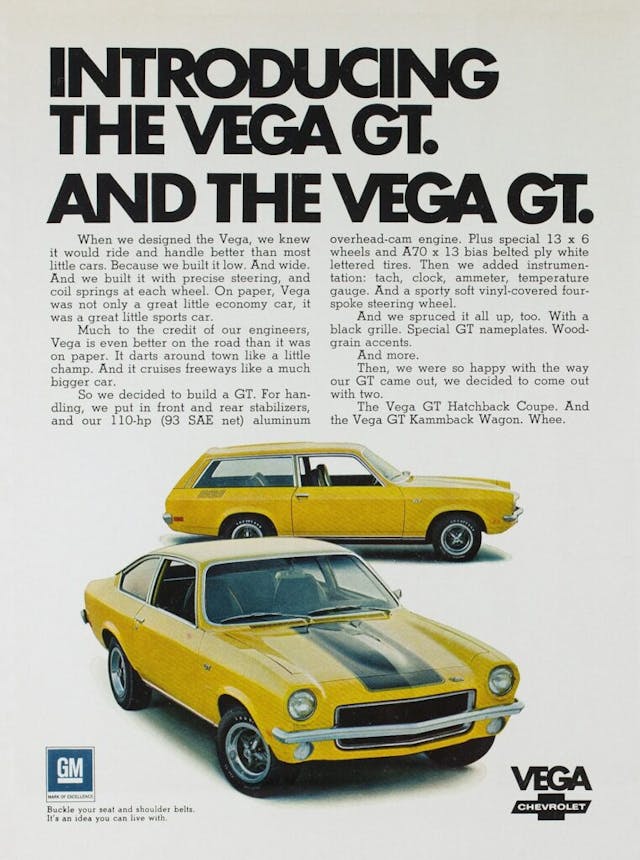
As a young Chevrolet engineer at the time, this writer had the opportunity to take home a 110-horsepower, four-speed manual, early build Vega hatchback for a weekend a couple weeks before its September 10, 1970 launch, and I was seriously impressed by the way it looked and drove. So were the friends I let drive and ride in it.
“We call it Vega 2300,” said Chevrolet’s October 1970 launch ad. “We also call it, ‘The little car that does everything well.’ Because it does. Vega moves well, stops well, steers well, rides well, handles well, responds well, passes well, travels well, parks well, wears well, and is priced well under what you’d expect to pay for such a talented little car.
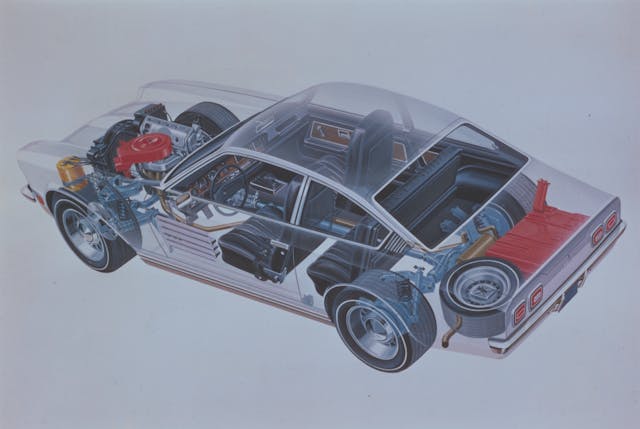
“In our highway tests, Vega has been getting gas mileage in the neighborhood of the little imports, which isn’t a bad neighborhood. Yet, unlike your average little car, ours steps right out when you step on the gas. The engine is a specially designed overhead-cam four with a lightweight aluminum alloy block. It turns slowly and quietly at turnpike speeds, with power to spare. Disc brakes are standard in the front. So are bucket seats, except on the truck.” Base price (with a three-speed manual transmission) was $2090, while the hatchback stickered for $2,196, the Kammback wagon for $2,328 and the “Panel Express” truck for $2,138.
It also impressed the editors of Motor Trend, who assembled an ARS (Conference of Automotive Research Specialists) panel that included ace racer/racing school founder Bob Bondurant, renown auto engineer/journalist/author Karl Ludvigsen and its own staff to evaluate and test the new domestic models. “In a conference room in Palm Springs, California,” they wrote, “after a grueling 4-day ride and drive that saw Detroit’s finest put through a 1,000-mile wringer, we … cast our votes and made Vega 2300 Motor Trend‘s 1971 Car of the Year.” Bondurant commented that he had been away from American cars for about five years, “and it is pleasantly surprising to see how good they’ve gotten, especially these new little ones.”
The bad
Yet Chevy’s new small car, despite its noble intent and initial promise, seemed cursed from its beginning. A massive UAW strike halted production for several weeks after just 23,000 Vegas had been built, and its innovative, single-overhead-cam, sleeveless-aluminum-block 2.3-liter (140-cubic inch) four-cylinder engine—already handicapped by a low 8.0:1 compression ratio to meet emissions mandates on no-lead gas—needed at least another year of development. GM Research had been experimenting with sleeveless (for lower cost and weight) aluminum-block engines since the late 1950s, and this one’s design started at GM Engineering, then was handed over to Chevrolet Engineering to test, develop, and optimize for production readiness. Among other issues that would surface during its early production years: its silicon-impregnated-aluminum cylinder bores tended to lose lubricating effectiveness over time, especially in cold weather, leading to piston scuffing, high oil usage (exacerbated by failure-prone valve-stem seals) and even some piston seizures.
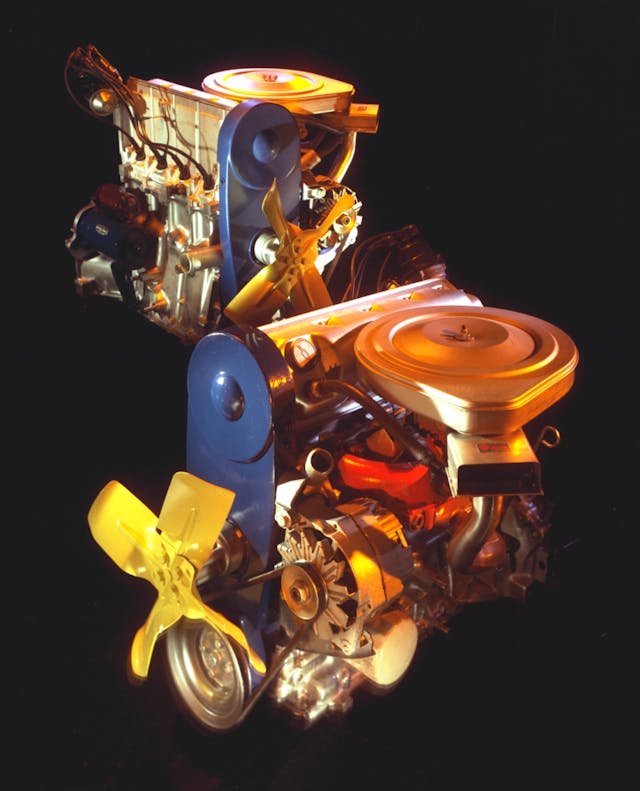
Says Ludvigsen today: “I recall being at the Vega launch and riding with [then Chevrolet assistant chief engineer] Lloyd Reuss in one of them. He was telling me how they’d done their homework by looking at similar-sized engines from other makers. Aware as I was that the BMW 1600 was a superb OHC engine … I said, ‘Did you look at the BMW?’ ‘No,’ he replied, ‘We didn’t look at that.’ That was a big oversight”—probably because they were benchmarking engines from lower-priced, higher-volume cars.
The Vega’s barely adequate, six-quart cooling system and tiny (foot-square) radiator also caused problems when owners didn’t keep them fully filled. “In combination with leaking valve-stem seals, the engine would often be low on oil and coolant simultaneously,” Lamm wrote in CA. “This caused overheating, which distorted the open-block deck, allowing anti-freeze to seep past the head gasket, causing piston scuffing inside the cylinders … Chevrolet added a coolant-overflow bottle in 1974 and an electronic low-coolant-level indicator for 1976.”

Then there was the tendency of the screws holding the optional 110-horse engine’s Rochester two-barrel carburetor’s top cover to loosen due to the engine’s strong vibration at some rpms. “The top cover would then jump up and down,” Lamm wrote, “which activated the accelerator pump, which shot raw gasoline through the cylinders and into the exhaust system. Fuel would puddle inside the muffler and eventually explode: backfire.” All these issues and more despite Chevrolet’s claimed six million miles of engine testing.
“Once on the West Coast I had a Vega loaner from GM,” Ludvigsen recalls. “I was running around on various calls, and at a certain stage the engine started running roughly. Very odd. I lifted the lid and looked around … the major screws holding the carburetor together had come adrift from the engine’s vibration!”
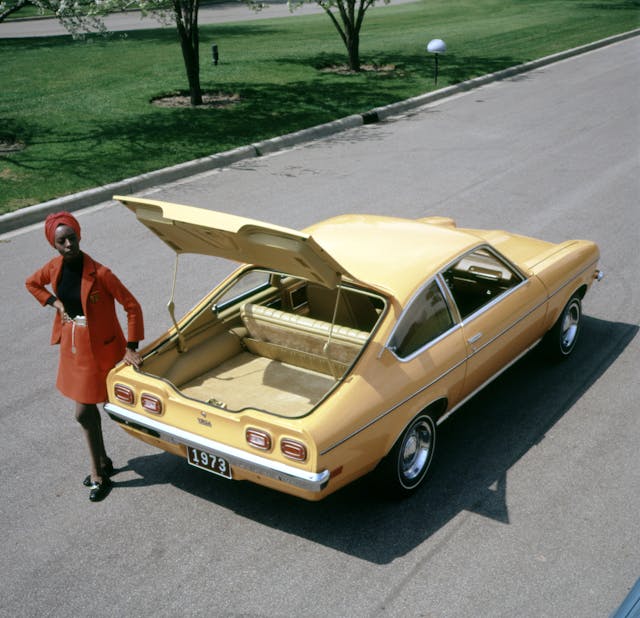
Other problems included rust resulting from GM Fisher Body’s highly touted, rust-preventative Elpo dip primering process not reaching all nooks and crannies of the Vega bodies. And some related directly back to unwise cost-cutting. The Vega program was GM’s first to be designed and developed by a cross-functional project team led by a single chief engineer/program manager, initially James G. Musser, Jr.
And Cole’s direction was to make it as inexpensive to build as possible at GM’s then-new and highly advanced Lordstown, Ohio assembly plant at the very aggressive rate of 100 cars per hour, nearly twice the typical 55-60 per hour. And when DeLorean replaced Estes as Chevrolet general manager in early 1969, he appointed Reuss to succeed Musser as Vega program manager with a mandate from Cole to “cut costs but don’t cut anything else,” according to Lamm.
Car and Driver, in the same September 1970 story that praised the Vega’s performance, handling and styling, also cited some negatives: “On the other side of the ledger, mountains have to be climbed in second gear (which is good to about 80 mph), it will stumble to its knees whenever you try to launch it rapidly from a traffic light because of its incredibly long axle ratio, and a print-out has determined that the steering could be no less than 4.4 turns lock-to-lock because everything quicker would raise the parking effort above the arbitrary maximum.”

In a December 1971 CD comparison test of six “Super Coupes, the New Breed of Enthusiasts’ Cars,” Vega finished next to last, ahead of Ford’s equally new Pinto but behind the winning Opel 1900 Rallye, a Mazda RX-2, a Capri 2000 and a Toyota Celica. “We’ve always thought of the Vega as a well-engineered car,” the article said, “but many of its virtues are blocked by some equally impressive vices. For one thing, it’s noisy—the noisiest car in the test—and most of it can be blamed on the long-stroke four, which vibrates the hell out of the car. Under full-throttle acceleration, there is a period at 4800 rpm (47 mph in second and 74 in third) that registers a full 88 dbA at the driver’s ear, and that, friends and neighbors, is NOISE. None of the other test cars were [sic] even close. [This CD test car was clearly not the one they had reported in September as “cruising silently” at highway speed.] And the Vega is considerably noisier than the others at a constant 70 mile per hour, too. The really sad part about this is that the Vega has an elaborate sound package, a thick blanket under the hood, padding under the carpet and deadening material stuck into many of the body’s underpanels, all of which contribute to its being the heaviest and slowest car in the test—and it’s still noisy.”
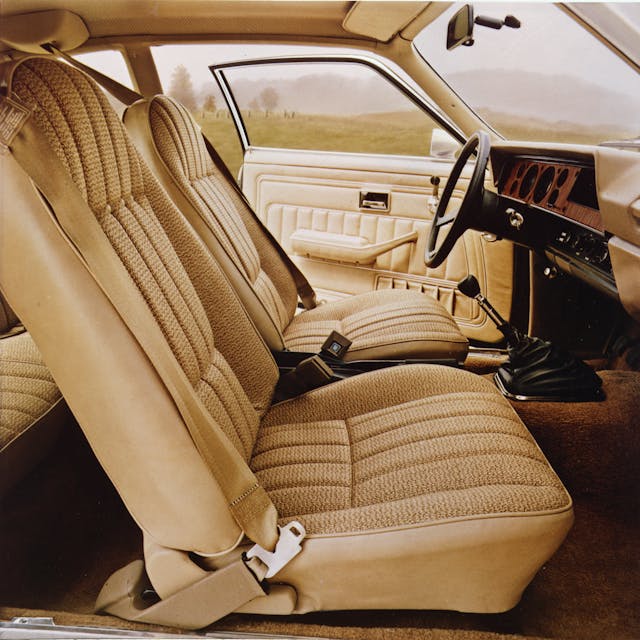
Bob Storck, a knowledgeable journalist with personal Vega experience who was a consulting engineer for GM-supported race teams and Milford proving ground contacts at the time, sums up the car’s problems: “The same Reynolds aluminum/silicon-imbedded cylinders worked great for Mercedes but with better attention to piston plating and proper aging of the cylinder bores. The attempted fixes for drivetrain vibration—heavy dampers, coatings and sound proofing—more than offset the weight savings from the aluminum block. A failure-prone cam belt that was not warranteed. The base three-speed transmission, the original two-barrel carb, the optional two-speed automatic and the iron cylinder head, all entirely price-driven. And the almost vertical nose-down shipping, which created compromises to cooling and oiling. The combination of the all-new car platform, new engine, new shipping process, new technology and new factory were too much to overcome, especially with a young activist labor group and a litany of management fiascos.”
The ugly

A few months into the build, Vega production reached 73.5 per hour, and the cars were relatively well built. “They still had mechanical flaws,” Lamm wrote, “but the quality of assembly—things like fit and finish—was not a problem.” Then in October 1971, GM’s newly created GM Assembly Division (GMAD) took over the Lordstown plant from Chevrolet and Fisher Body and angered the union workers by laying off some workers (to improve efficiency) and tightening discipline.
“Feelings between GMAD and the UAW grew progressively worse,” Lamm continued, “with management accusing workers of intentionally slowing the line and sabotaging cars by leaving off parts and doing shoddy work. The workers countered that GMAD sped up the line and cut staffing. Whatever the truth, quality did suffer and, in March 1972, the UAW called a strike that lasted most of that month.”

GM recalled hundreds of thousands of Vegas three times in 1972. The first was 130,000 cars with the optional L-11 two-barrel carburetor for potential fires caused by engine backfiring that could blow out the muffler and heat the fuel tank to where it leaked. The second was 350,000 cars with the standard one-barrel carb because an emissions system component could fall off and jam the throttle linkage. The third was 526,000 Vegas with rear axles that could separate from the car enough to drop it down on its rear suspension. At one point, safety crusader Ralph Nader went after the Vega as “sloppily crafted, unreliable and unsafe.”
The rest of the Vega’s story

To his credit, DeLorean tried hard to improve it and its reputation. He put additional inspectors on the assembly line, introduced a computerized quality control program that had each car inspected as it was finished and repaired if necessary and pushed updates and fixes into production as quickly as the system would allow.
An optional GT package (the 110-horsepower L-11 two-barrel engine, F41 handling suspension, special tires and trim) for the Hatchback and Kammback was added in mid-1971. Then for 1972 came a revised exhaust system and drivetrain to reduce noise and vibration, plus recalibrated shocks and an optional three-speed automatic. Unfortunately, further mandated emissions reductions dropped the base engine to 80 horsepower and the optional four to just 90 horsepower. The next year saw some 300 changes, Chevrolet said, including five-mph front bumpers, a new Holley two-barrel carb for the optional L-11 engine, a new four-speed Saginaw manual transmission and linkage, new LX notchback and (woodgrain-decaled) Estate Wagon models and a limited-edition “Millionth Vega” commemorative model, of which 6500 were built.
For 1974, there was new front styling, five-mph rear bumpers, a 16-gallon fuel tank replacing the previous 11-gallon tank and (in January) plastic front fender liners—after the rusted front fenders of thousands of 1971-74-models with no inner fenders or fender liners had been expensively replaced under warranty. There was also a “Spirit of America” limited-edition hatchback model. And in May of that year, Chevrolet, under new general manager Robert Lund, notified the approximately 1.3 million Vega owners at the time that it would cover under warranty the cost of any engine damage caused by overheating.
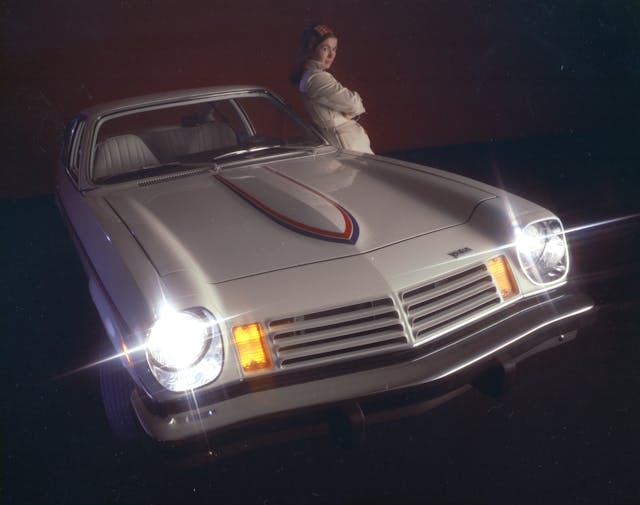
Important among Chevy’s claimed 264 changes for 1975 was new High-energy Electronic Ignition (HEI) and an upgraded catalytic converter, and the (relatively) high-performance Cosworth Vega was launched. Even as Vega sales were sagging due to its many problems, Chevy said it made another 300 changes for 1976 beginning with substantial cooling and durability improvements (including hydraulic valve lifters and long-life valve stem seals) to the 2.3-liter engine—by then delivering just 70 horses in base form and 84 with the two-barrel carb. And that updated “Dura-Built” engine was covered by a five-year, 60,000 warranty. That year also brought another facelift and a substantially upgraded chassis (shared with the new ’75 Chevy Monza) with a box-section front cross-member, larger brakes with vented front rotors, and extensive anti-rust improvements, and the slow-selling Panel Express model was discontinued.
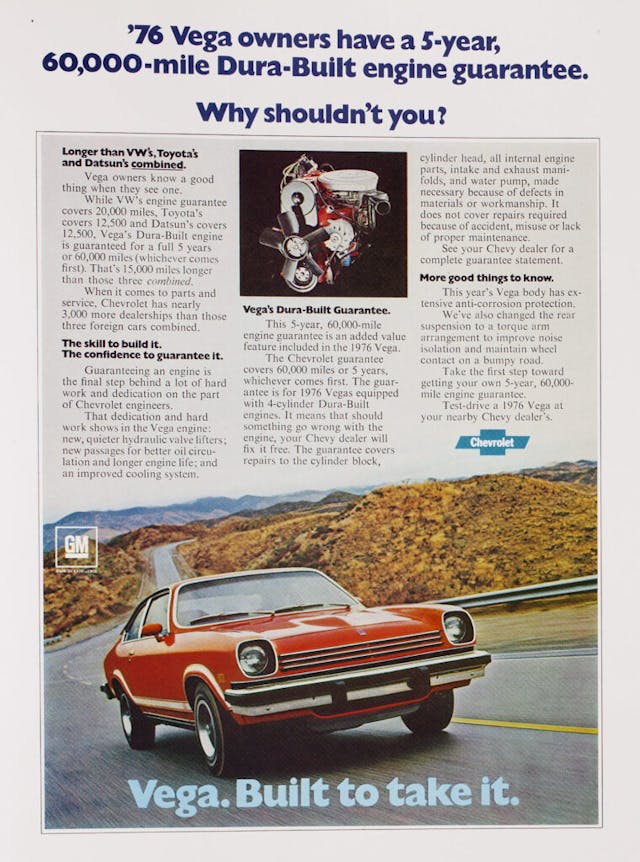
“For 1976,” Lamm wrote in CA, “GM finally started to get it right.” Among the new options were a Borg-Warner five-speed manual gearbox, a sliding glass “Sky Roof” and an eight-track tape player, and new models included a GT Estate Wagon, a notchback Cabriolet and a limited-edition Nomad wagon. Chevy’s Vega was by then a pretty good car … but way too late. And the notchback sedan’s base price had inflated to $2,984 and the more popular sporty hatchback to $3,099. Total ’76-model sales sank to 160,524 (including 1,447 Cosworth Vegas) from their ’74 post-fuel-crisis peak of 460,374.

Few changes beyond further emissions improvements came for ‘77, which would be Vega’s last model year. Just 78,402 sedans, hatchbacks and Kammbacks were built as the new-for-‘75 Monza—built on the Vega’s platform and sharing its 2.3-liter engine and powertrain—displaced it as Chevrolet’s subcompact entry. Interestingly, the Monza was designed to accommodate GM’s Wankel rotary engine, which was also intended as a Vega option (as was a V-8). But GM eventually gave up on the Wankel due to unresolvable cost, emissions, fuel economy and oil consumption problems, so no rotary (or V-8) Vegas were built.
The Chevrolet Vega was a textbook case of General Motors introducing an all-new car well before it was proven and ready, then spending multiple years and millions of dollars trying to fix it on the fly even as its increasingly bad reputation was sinking its sales. We’ve written about such cases in the past (Pontiac Fiero, Buick Reatta and Cadillac Allante come to mind), but probably none so important and ultimately disastrous as this all-new small car that GM needed so badly as the 1973-74 oil embargo was killing its bread-and-butter big cars and elevating small, fuel-efficient imports to levels they would grow and maintain to this day.
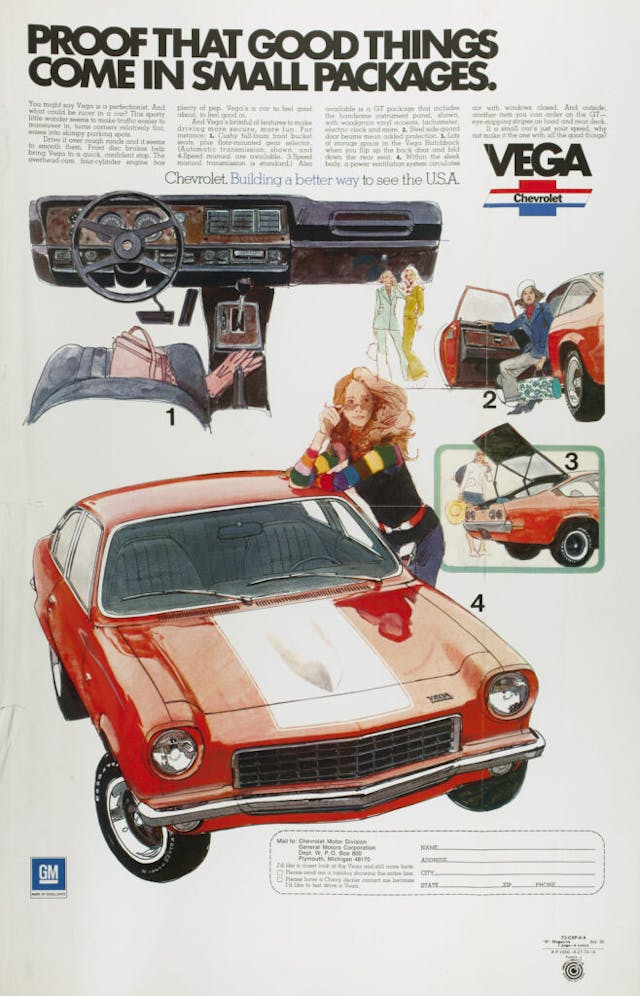
As we said up front, the Vega was not really a “bad car.” It was a brilliantly conceived, breakthrough domestic small car that was sadly cost-cut, poorly executed, under-developed and hurriedly launched to a sorry result well beyond Chevrolet’s and GM’s ability to save it.
***
Check out the Hagerty Media homepage so you don’t miss a single story, or better yet, bookmark it. To get our best stories delivered right to your inbox, subscribe to our newsletters.
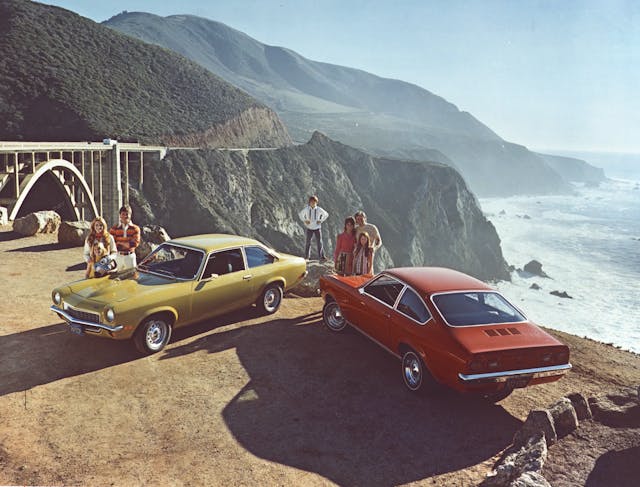
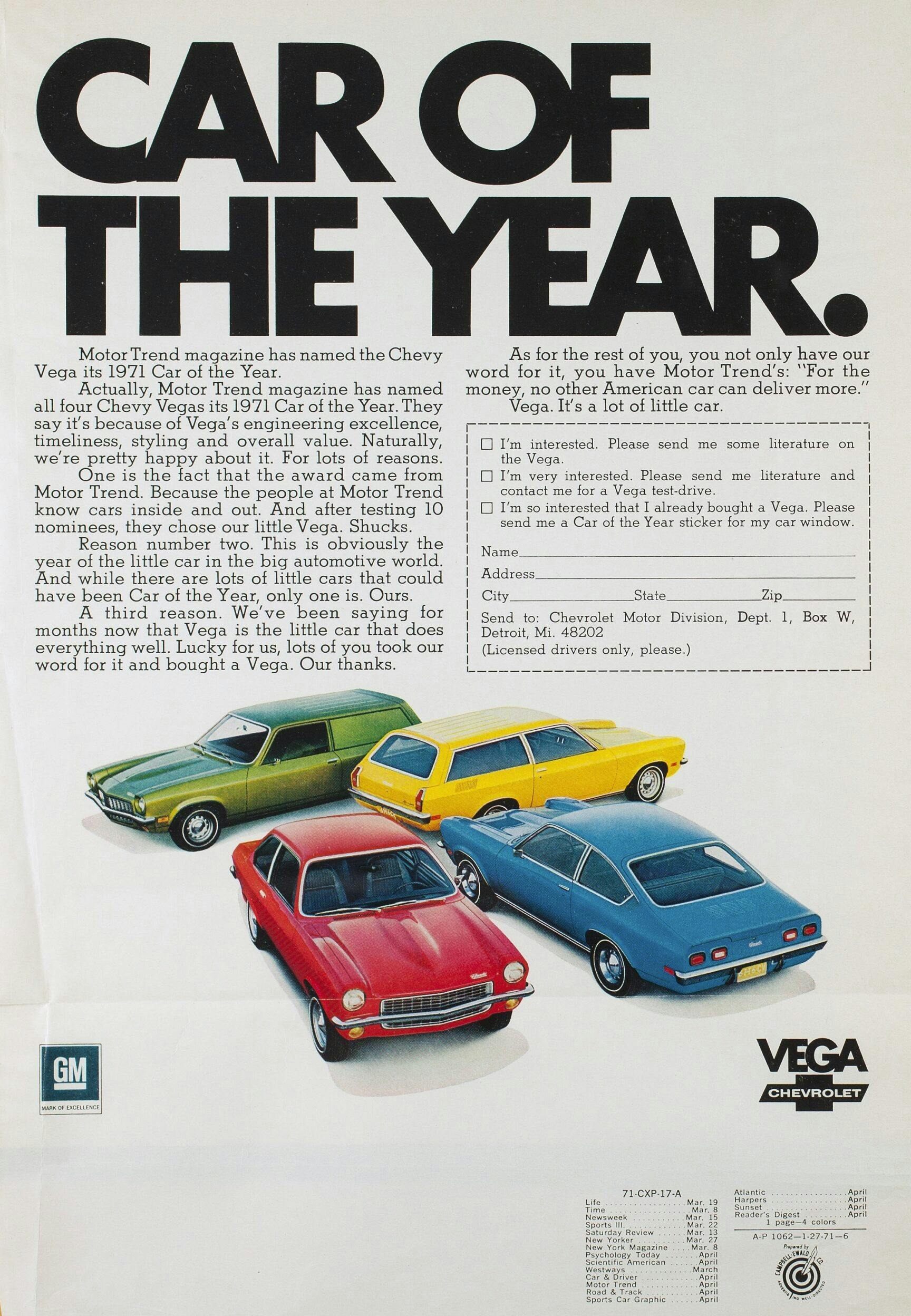

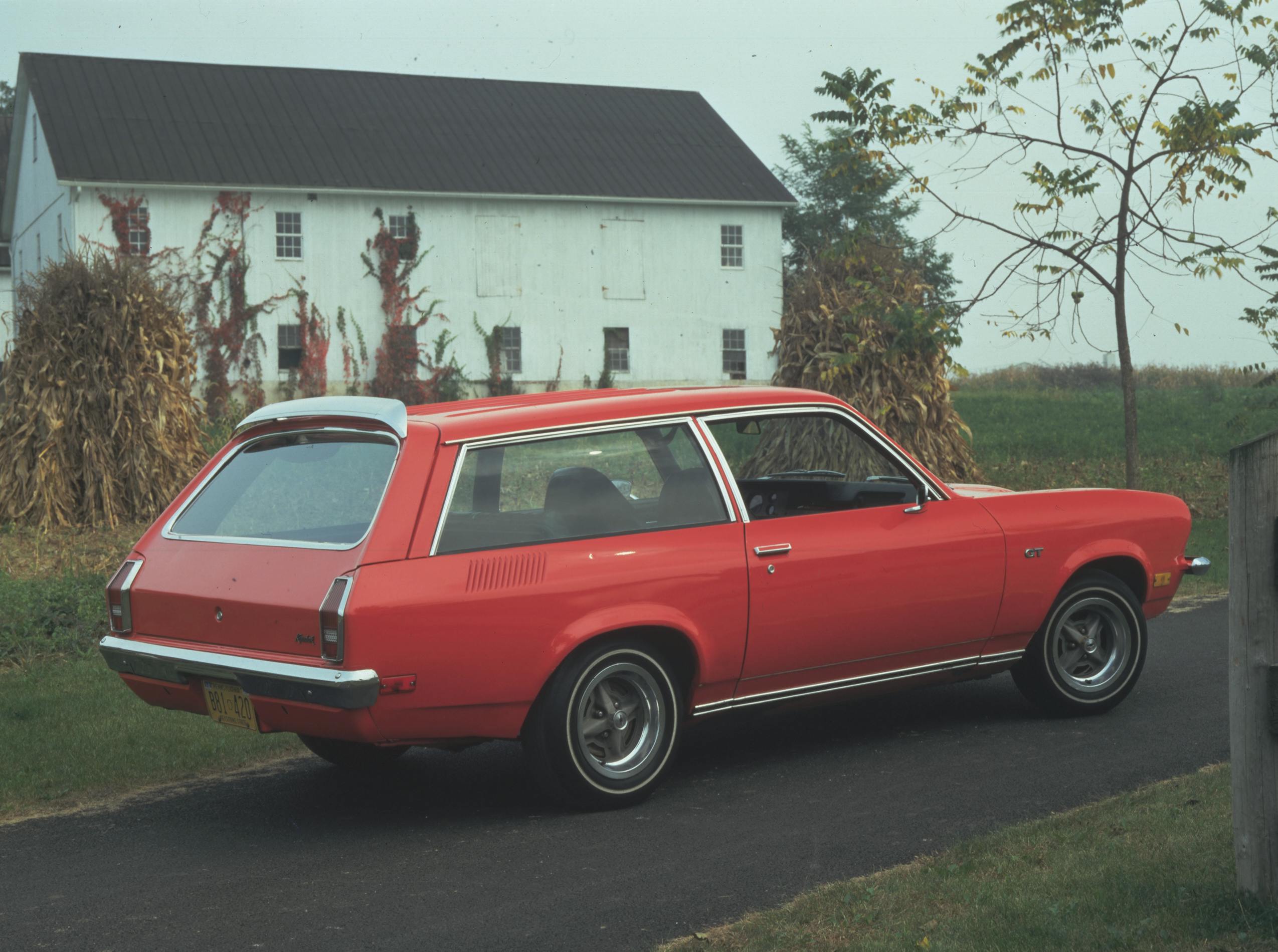

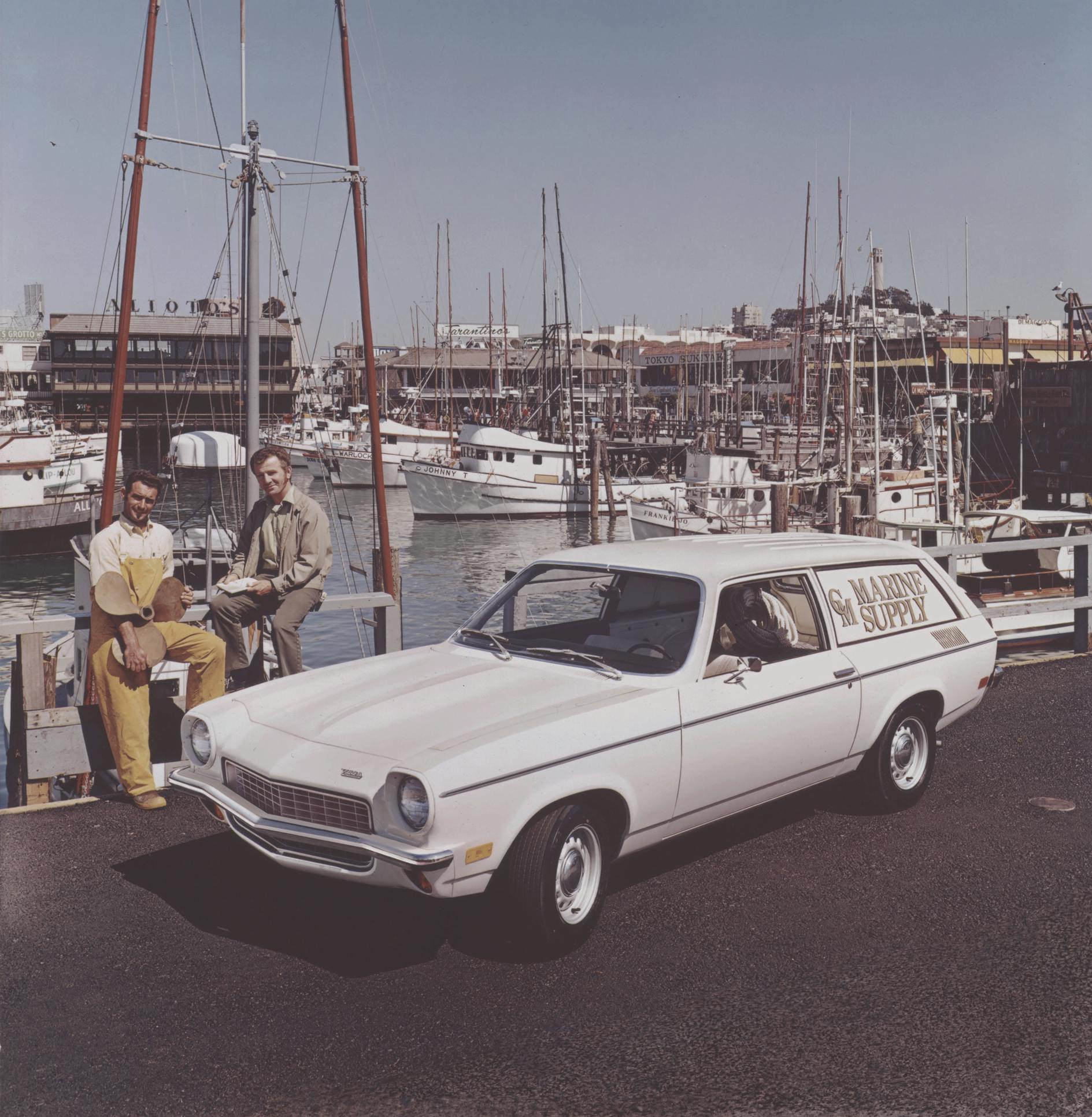
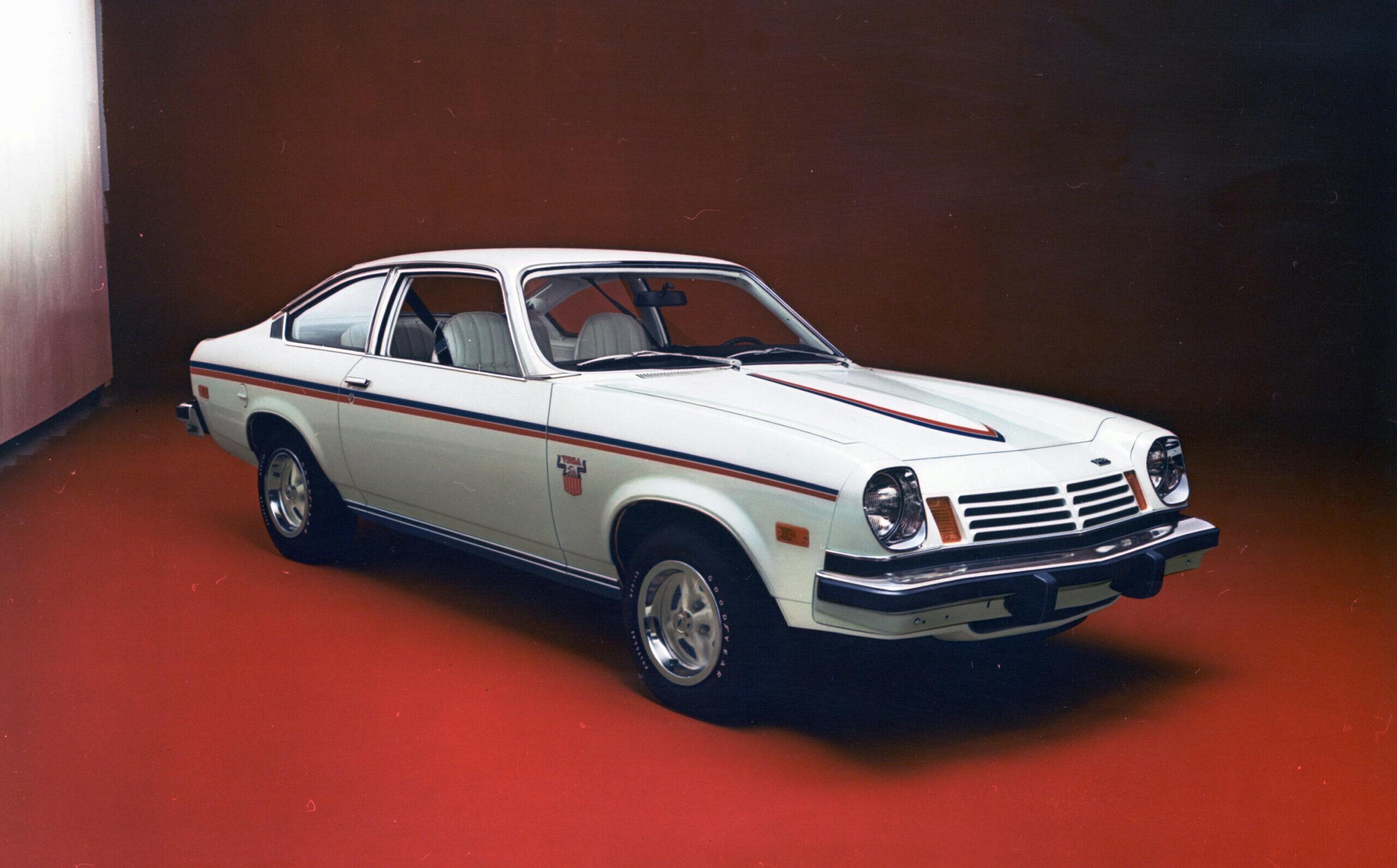
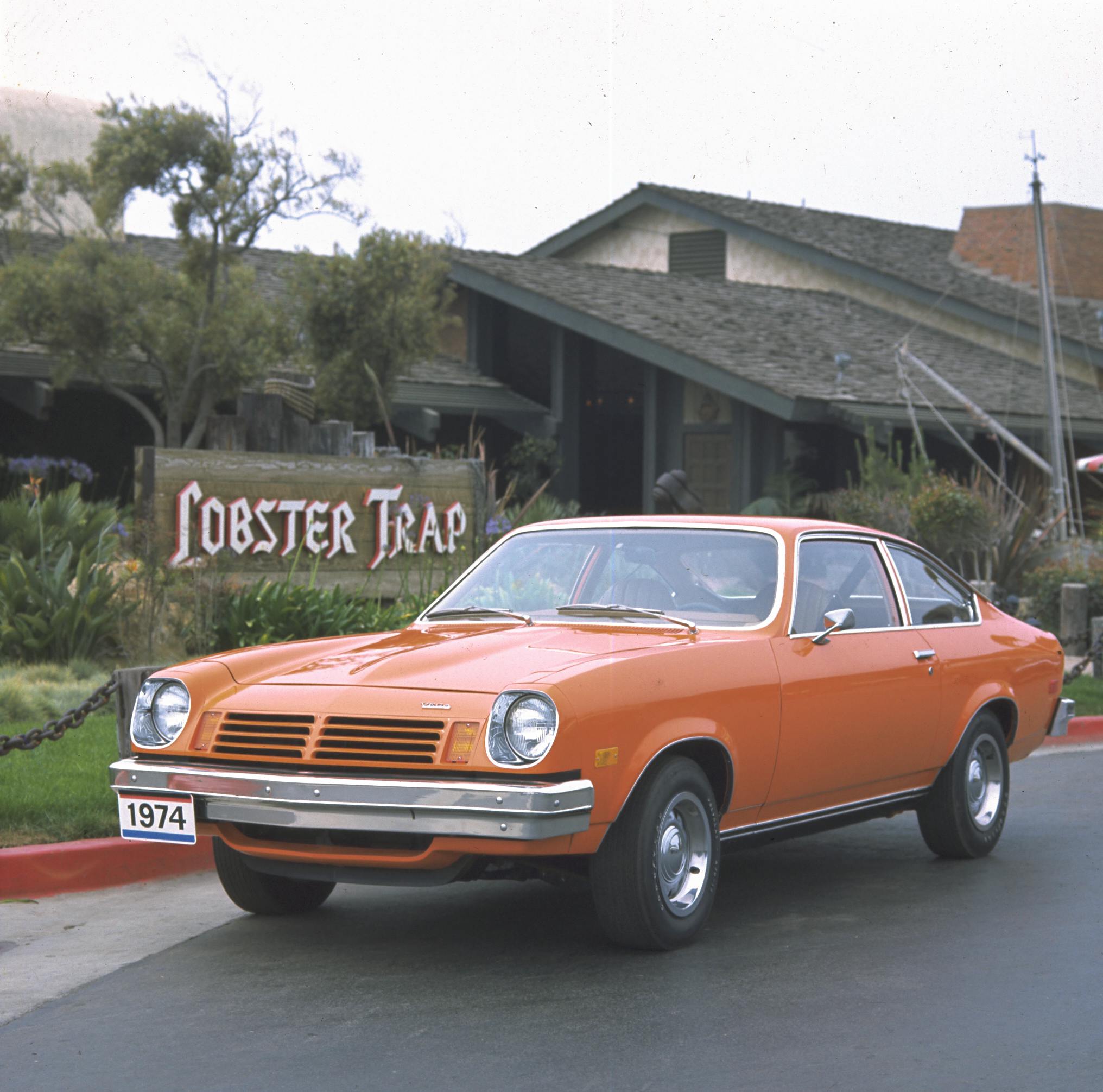
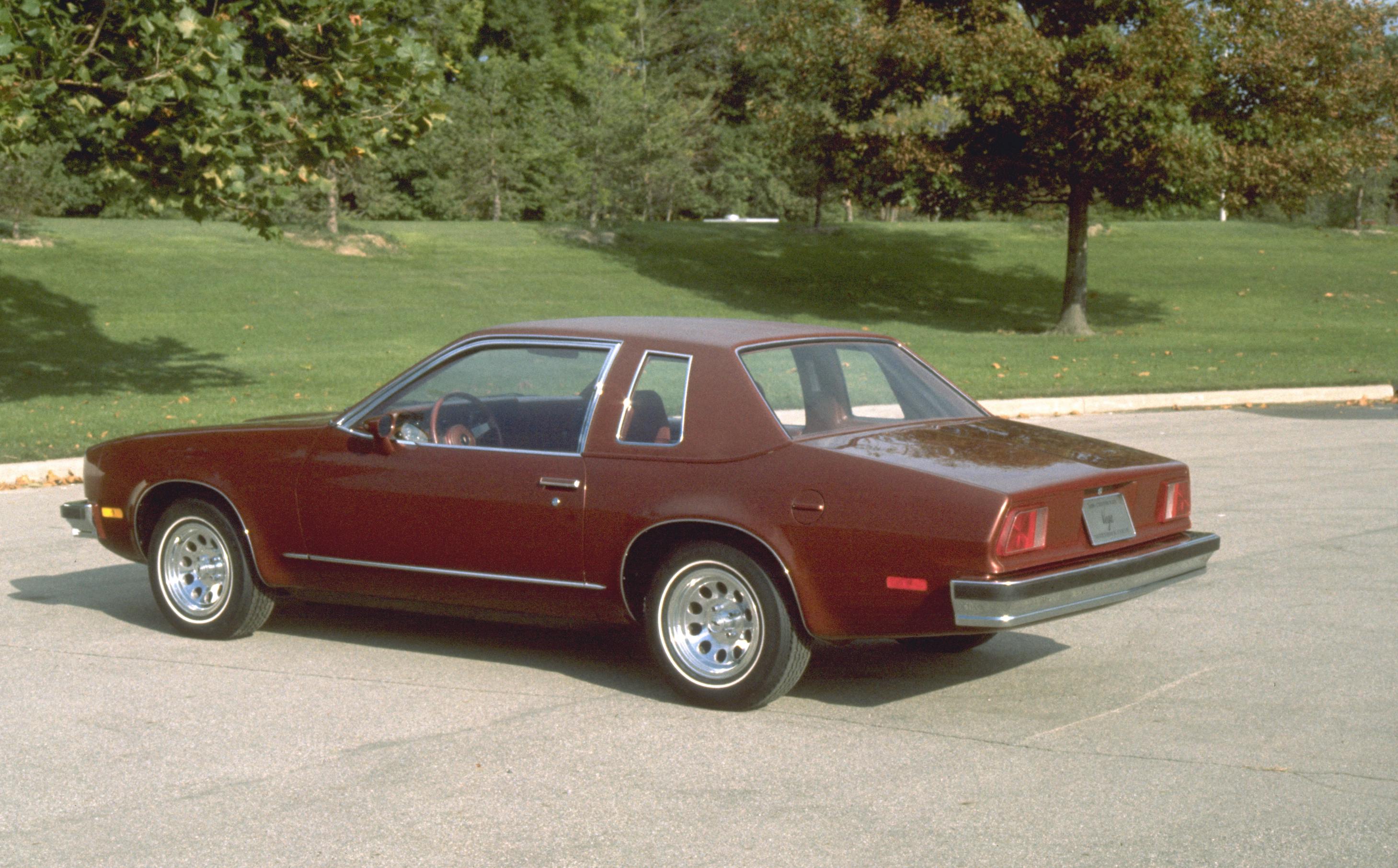
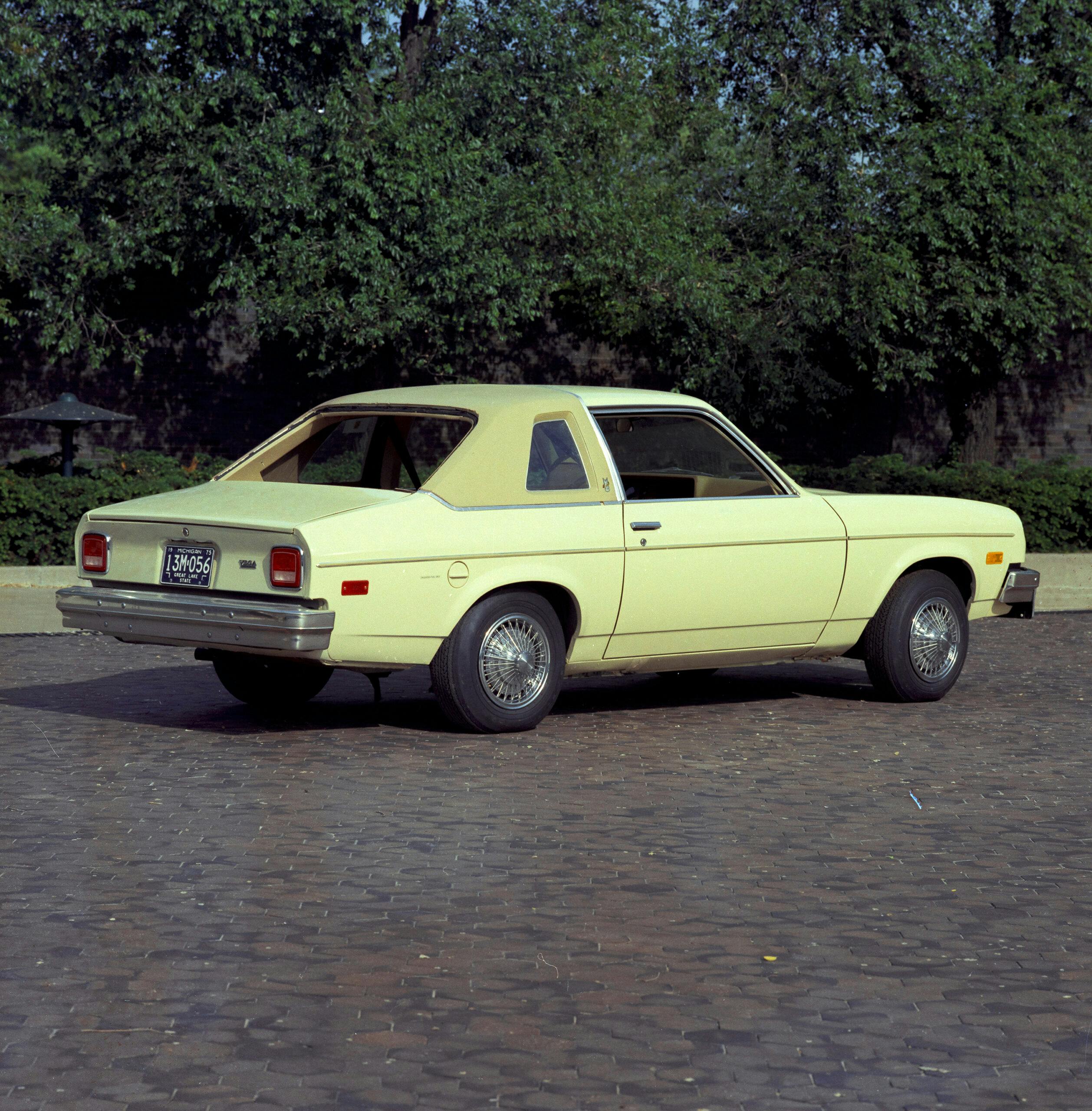



While Cole got some things right he also failed in other ways. The Corvair engine failed because #1 it cost more to build than a 327 V8. Cole also was a major force behind the rotary engine. Both it and the Corvair had major issues with emissions. The Wankel also liked to use a lot gas.
As for the Vega. Three things would have saved the car. One Better rust proofing. But to be fair Ford, AMC and Mopar had the same rust issues.
#2 Iron Sleeves in the block. This tech came from Can Am and the McLaren 427. It worked there but then again these were not high mile engine.
#3 Finally better quality control.
Time was not so much the trouble as cost savings.
Cole also was moved up before the intro and Delorean was faced with a intro of a flawed car and he knew it. He was limited with options and he could not stop the intro. The later cars were better but it was too late.
We grew up on Vegas for winter beater cars. We had 60’s muscle cars in high school in the 80’s as they were easy to find and cheap. We used Vegas to beat the salt.
Yes they rusted, They used oil but no matter what or how cold they started and ran. We used two liter bottles of used oil from work or shop class to keep them full and it was going to burn anyways.
A neighbor had one and he saved it from a junk yard. He drove it two years and junked it. Then it came out again went another two years. I have other similar stories.
These things always ran and were cheap to keep on the road if you has a place to get used oil.
We dipped into Cosworths as two brothers bought a pair of them. These were cool cars but never really fast. Delorean tried to fix things but the cars end was near anyways.
The truth is most cars of the 70’s were flawed. Oil leaks and rust were common with all of them. It really was not a very good time for cars or ownership.
We see some of these cars today restored to levels they never were originally. We are amazed by them. I forgot till I took a neighbors all original Gen2 Camaro. It has 11K miles, but it paled to the restored cars of today.
Hyperv6 is correct in that nearly all of U.S.-made cars of that era experienced the same or similar issues – they weren’t just Vega problems. With the gas crisis and emissions mandates hitting at the same time, engineers in all of the manufacturers were scrambling for quick answers, many of which were not proven out in the long run. The big failure I see there, though, was that the “suits” let the imports (mostly from Japan) get such a large foothold before they woke up to what was needed. Playing catch-up from that far behind is seldom successful.
Well the industry take time to change and they just did not have that time.
As for the imports they suffered issues too. While they did get good MPG they did not hold up well in our northern climates. They rusted out like very Vega and Pinto.
If you look around today there are few Honda or Toyota cars of this era left. They were somewhat disposable too.
We are in a similar era of change with the force EV mandates. This is leaving us with a mix of issues and problems that the automakers are trying to deal with in such a short time to change over.
It took nearly 20 years to recover from the 70’s cars and I wonder if they will recover with this change. Many may not survive the changes as due to the costs.
I owned a 1976 Vega hatch and it was easily the most comfortable small car I’ve owned. The cool thing about it was that it was a manual steering car that the previous owner had fitted with a 327 V8. Even with the little V8, the car had a comfortable ride and was a nimble handler. If the modern LS motor had existed, the V8 version would have been a natural. The author does a great job laying out the bad and the ugly. Truth? Those non-sleeved aluminum engines were the death of Vega.
Funny, I still have a 63F 85 Oldsmobile. It’s got a 215 all aluminum V8 that GM started using in 1961. They used sleeves in that engine and they ran a very long time with no oil consumption. I never understood why they didn’t do that to the early Vega engine.
They tried to replicate what Porsche was doing with that same alloy, it worked for Porsche, because they had a different casting process that allowed the silica crystals to properly form, the process GM used allowed it to cool to quickly and the crystals never formed correctly and left it with a soft cylinder lining. I read an article that went deeply into this years ago, but must being a metallurgist I don’t remember all the details. It apparently was investment casting vs the other.
I drove a 77 Vega in high school in 1984 and 1985 and we fitted a 327 in it in my shop class. It’s still my favorite car that I’ve owned to date. Wish I still had it.
I had a ’71 Vega Wagon which I loved .It was a great little car for the money . I drove it from FLA.to Texas in 1974 and never had a problem with it. It was a pretty car and handled well. I later traded it off ,I guess before the silicon cylinder wall problems arose.
I later when I stated buying and selling cars ,bought a 1972 notch back and rebuilt the engine installing cast iron sleeves in the cylinders . That worked great.
Another time I got a ’71 and put a 283 v-8 in it and that was interesting.
You could listen to them rust
I put a Ford V6, the 2800 cc Cologne engine, in my 74 Vega, with a 4 speed manual. It made a pretty nice car, for a long time. But rust finally got it. My wife refused to ride in it after the cowl rsted, and water dripped on her feet.
My father loved these cars. We could pick up a “skeeter” killer, sleeve the block, rebuild the head and have a good cheap car. My father , my mother and my sister all drove them and dad kept a rebuilt engine, tranny and rear end all ready. I parted out a spare car for him .
2 buddies had these. One a base 2 door which had about 70000 miles on it when driving home from Toronto after a concert the oil pressure light came on. I said you’d better stop and check it out. He did, said there was no oil on the dipstick but we had to get home as it was 2am in the winter and we both had to be to work that morning. We drove another 85 miles and started to hear knocking. About 15 miles later there was a big bang and the car rattled along. We pulled over, lifted the hood and saw a connecting rod laying through a hole in the block. He put another 3000 miles on that car without fixing it or adding oil. The con rod flopping along. The other was a kammback which was a nice car albeit noisy and with glacial acceleration. He had it for 3 years and it got t-boned. End of story. Could have been a great car if they’d waited another year to properly sort everything out.
This was a great article on what could have been. I owned a sedan and a hatchback and they served me well as a daily driver for years. I liked the styling of the hatchback and unfortunately both cars succumbed to the engine and rust issues. Long live the Vega!
A fair assessment of the Vega. GM was so close to having a world beater. My father bought our ’71 in 1973 with about 60K miles and knew the engine was blown but GM replaced it for free. At the same time it got the coolant overflow tank and the 12×12 radiator replaced with the HD. That engine ran 150K miles when I rebuilt it in 1984. I did a valve job in late 90’s but the bottom end is still untouched and the car is now approaching 400K total miles. I also have a ’74 with 200K+ miles and a 130K+ mile engine. I have put larger radiators in mine to handle the Texas heat without worry and always given them gentle warm ups. Besides the great handling the best thing about any Vega is the ease of maintenance. I love not ever being held hostage to auto repair shops. I still drive one of these every day and like the way they drive much better than any of their modern counterparts I have tried. Keep the oil in good shape, make sure they NEVER run hot and attack any rust as soon as it appears and might run forever.
Simply awesome my man!
Still remember studying the mismanagement of the Vega in graduate school. It was a basic manual of what not to do.
The Vega was nice looking and theoretically good but GM put too much effort in the wrong place, and then piled on the cost cutting. If the time and money wasted on vertical shipping was spent on engine reliability the Vega would have been much better. For that matter using the Vauxhall slant 4 instead of engineering this too clever by half Nikasil block with a penny pinching iron would have been smarter.
Ford made an SOHC four that was good enough to produce for over 30 years. The Vega didn’t make it to 7 years.
I had a new Vega GT. Hated that car with a passion. Worst riding car I’ve ever owned. Sold it after only a few months.
I had a customer that drove a gold painted Vega wagon with a plate on the dashboard, lettering on the door handles, and chrome script on the back proclaiming the car was the 1,000,000 Vega made. There wasn’t much more of the car that wasn’t badly rusted or falling apart. Story was the car was given to this young lady to move from Michigan to Tennessee. I wish I had gotten photos but this was 1977 or so and didn’t have a camera in my pocket like now.
Bob Stempel, was in charge of the sleeveless Aluminum block. Didn’t end his career, he went on to be president of GM. He did get it fixed…but as you will read too late to overcome the sigma. As with the rest of the car, still needed about a year of development. But the reality is profit/cost, and they needed to start selling to meet financial goals. This is the case with many vehicles, sometimes the flaws are not significant enough to end a vehicle. The Vega was not one of them. I still remember seeing my first one ( was in middle school walking home), and thought what a good looking car! Like someone said what a great business case in how to fail!
I had a ’72 Vega GT in 1978. Couldn’t keep gear boxes in it. I put a small block Chevy and AT in it and had a ball. The 3:36 rear gear gave it great acceleration but Spyder gears wouldn’t last. Lots of fun. Would build another but those are too rusty now.
I built a 74 Vega GT hatchback with a 350 V8 in 79 as a senior in high school. Added a narrowed 12-bolt rearend (stock tubs) and Turbo 400 trans. It was a pretty good car and I drive it for 6 years and approx 40K miles all through college and first year out of school. Helped that I lived in CA so rust was not a big problem. Although it still did have some small spots that I took care of. There were lots of V8 Vegas running around, as they were easy to find with bad stock engines and the rest of the car basically good shape. Several aftermarket companies made the V8 conversion kits, making it quite easy to accomplish the swap. I used an A/C Vega radiator that I had recored to a 4 core, although it still had issues running warm when I got stuck in traffic. Fine going down the road, just not good in stop and go.
Yep! Best thing you could do with a Vega was replace the engine with something different. Often the problem with the stock engine was being overheated & warping the block so much the head gasket wouldn’t seal. The center cylinders would just sink enough that they wouldn’t match the same plane as the end cylinders. I lived in SOCAL during that period & saw a lot V8 Vegas.